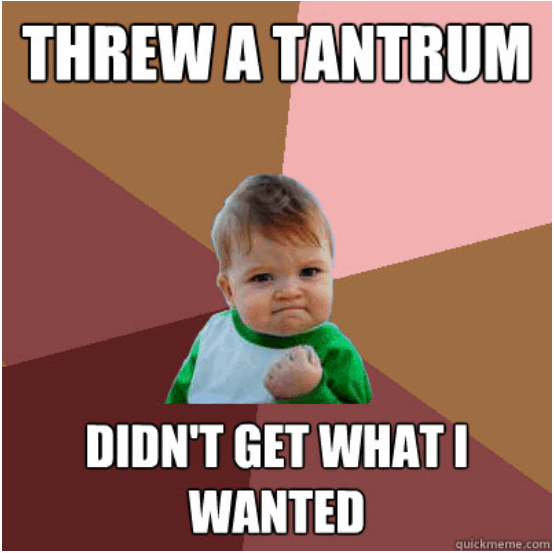For my son’s birthday, a dear friend gave him a swing that attaches to our porch. When we go to the park, all he wants to do is swing so this was such a thoughtful, perfect gift. He loved it! I mean we spent hours the first week it was hung swinging. One afternoon I was done. I no longer wanted to stand in the same spot pushing the swing any longer. I told him we were finished with the swing for today and he LOST IT – cried, threw himself on the ground, banged his fists, etc.
This went on for a full hour and part of me wanted to just give in and put him back on the swing – but the other part remembered that giving in now will only teach him that if he cries long and loud enough, he gets his way. So he had his meltdown, and I made sure he was safe and within eyesight (and played on my phone to distract myself for some of it). At the end of the hour he settled down. We sat and cuddled for a bit, and then we went on to have a wonderful afternoon/evening.
As parents, or really anyone working with young children, we cannot prevent all meltdowns. Having tantrums is actually a learning opportunity for children. It’s also how they express big emotions since they can’t engage in the coping skills we use as adults. They also learn to manage and regulate by our responses. So if they are going to tantrum, here are some tips to make it as painless as possible.
1. Remind Yourself: This is Normal
Tantrums are Developmentally On Target:
Toddlers are supposed to tantrum. I know this is not groundbreaking information, but sometimes we need to remind ourselves of this. Their whole life they’ve learned crying is how they meet their needs. It was their first form of communication, and it was a call to action for caretakers – feed, change, hold, etc. So imagine their surprise when they suddenly develop wants and preferences (that they cannot discern from a need) and we don’t immediately respond or comply.
Toddlers can’t tell the difference between a want and a need:
Let me say this again so you can really absorb the power of this statement. Up until this point, crying has been your child’s *only* way to communicate his needs. Yes, his needs. Tired? Hungry? Hot? Cold? Understimulated? Overstimulated? Needing to be soothed? Crying is all they had- and, if you were responsive to your child’s needs, then crying more than likely led to you attending to those needs. Now, your child has wants which are different from needs. I want to swing. I want the blue cup. But at this stage, your child does not understand that this desire is not the same thing as a need. They are not adults yet! Remind yourself of this.
Next: Your child tries new ways to what they want:
Your child tries all the new things they’ve learned like pointing to what they want, saying the word, actually asking, and/or saying please. If it is something they cannot have at that moment for any number of reasons, none of their newer communication skills are working to meet their end goal. They then revert back to a previous stage – crying! Again, because crying and tantruming always worked before. By allowing your child to tantrum, without giving in, we are slowly breaking that connection between crying being how they get anything they ask for. So if your child has tantrums – Congrats! You are teaching them, one tantrum at a time, the difference between a want and a need.

2. You Don’t Have to Fix It
Piggy backing off the point above, if they are tantruming over a “want” you don’t have to and arguably, shouldn’t fix it. Or maybe they are crying because they are overly tired from the day and just hit a wall. And in this situation, your child has nothing to need and you really can’t fix it. As long as their tantrum isn’t an attempt to communicate pain, hunger, *insert any other need*, then you don’t have to fix it. This is an opportunity for them to learn they can’t have everything they want, but they will still be ok. Or a change to express big emotions they don’t know how else to express. As long as they are safe, you don’t have to do anything else but let them get it all out.
3. Model Calmness (Even if you are Raging Internally)
Why does crying work so well? Because it is so annoying! Sometimes we just want to give in just to get it to stop (see point above – you don’t have to fix it). Sometimes we want to yell back. As we all probably know, and learned on our own a time or two, escalating the situation doesn’t work. If anything they cry louder and longer.
Instead, your child has a chance to learn from you how to manage emotions. If you are able to remain calm and composed, they are likely to calm down quicker as they attempt to regulate their mood to match yours. Try to act as if this isn’t a big deal at all. Feel free to carry on with what you were doing before the meltdown started. Fold laundry. Play on your phone. If you feel yourself wanting to snap back, or becoming angry, put in noise cancelling earbuds and listen to a favorite podcast. You can also just walk away to another room to distance yourself (as long as your toddler is safe).
4. Learn for Next Time
Going back to my child’s tantrum over the swing – I didn’t give him much warning we were about to get off the swing. Transition warnings help prevent many tantrums in our house, and this time I slipped and didn’t provide one. He probably would have had at least a mild meltdown even if I had provided the warning because he was so attached to that swing, but probably not the hour long terror that ensued. So this was a quick (well not so quick) lesson to remember transition warnings in the future.
Sometimes distractions or a quick change in scenery (it can literally be from one room to another) work. For many children, giving two choices prevents some meltdowns, as it gives your child an acceptable amount of control (i.e. “It’s time to go to bed. Do you want to change into pajamas or brush your teeth first?”). Again, we cannot prevent all tantrums, but by learning what works best for your child we can prevent at least some of them.

5. Enjoy the Calm after the Storm
After mine finished his meltdown regarding the swing, the rest of the evening was so peaceful and actually enjoyable! He also didn’t ask to swing the rest of the evening. Many months later, he still loves to swing almost daily. However, when I tell him we are almost done, he is agreeable and gets down with no fuss. Because he was able to have the big meltdown where he didn’t get his way, nor did he get yelled at, he learned a new boundary.
For most children, after most meltdowns, they are actually much calmer, sweeter, and more cooperative. It is really important after the tantrum ends to re-engage positively with your child, not hold the tantrum over their head for the next 20 minutes. Instead of annoyingly saying “Well that was a waste of our time” try empathetically “That was a big emotion, and you made it through!” Tantrums are exhausting for children too, not just adults. Sit and cuddle for a minute if your child needs too. Enjoy the calm after weathering the storm.

Nina Moak, LPC has a passion for helping children, adolescents, and parents with a variety of concerns including behavioral issues, school performance, anxieties, social issues, depression, and life transitions.
Other posts by Nina:
- The Benefits of Playing with Your Child
- How to Prepare your First Born for your Second Born
- 15 Minutes of Play Each Day Can Keep the Tantrums at Bay
- 5 Common Timeout and Ignoring Mistakes – and How to Correct Them
- 5 Ways to Make “Back-to-School” a Little Easier
As a Houston based counseling clinic, our caring therapists also offer therapy for
- anxiety disorders and anxiety treatment
- depression treatment
- obsessive compulsive disorder
- maternal mental health
- counseling for children
- therapy for teens
- insomnia
We also offer tips for improving your overall mental health on our blog.
Send an email to: info@hcfvl.com or call 713-331-5538 to learn more about how Houston Center for Valued Living can help you take the next step toward creating your best life.

